Goldmund Telos 590 Nextgen Integrated Amplifier
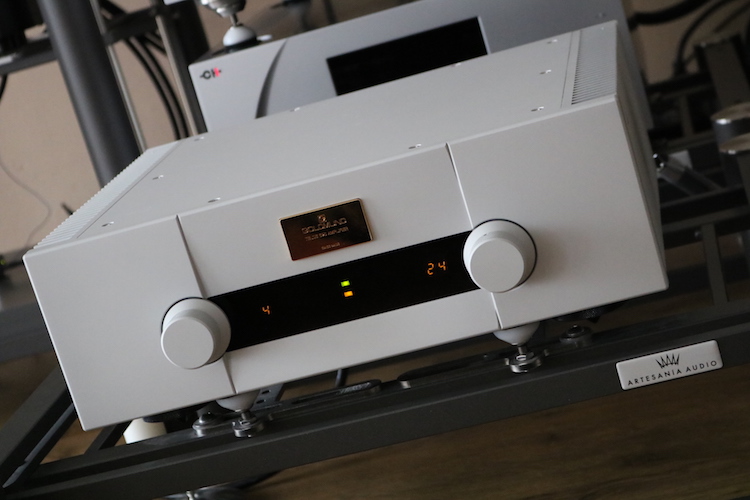
Review sample provided by PUUR audio, video & domotica
Retail price: 27.250 euro
Goldmund was founded in 1978 and has since been dedicated to the accurate reproduction of sound. The guiding principle at Goldmund to this day is to produce a precise sound with the least possible loss of quality.
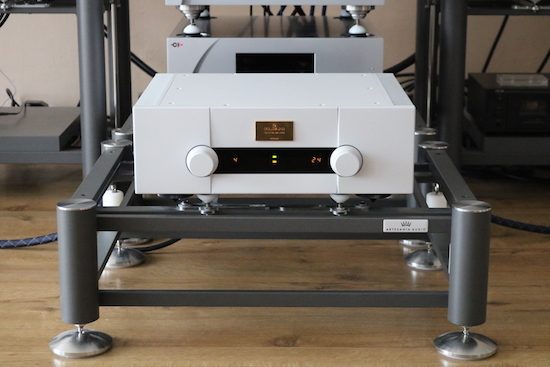
The Goldmund website has very little in the way of technical background info and the amplifier’s manual doesn’t add much beyond general information to get you started. It seems that for Goldmund, it is all about the end result which is the music, even if the underlying techniques are “invisibly” pushed to the extreme to achieve this.
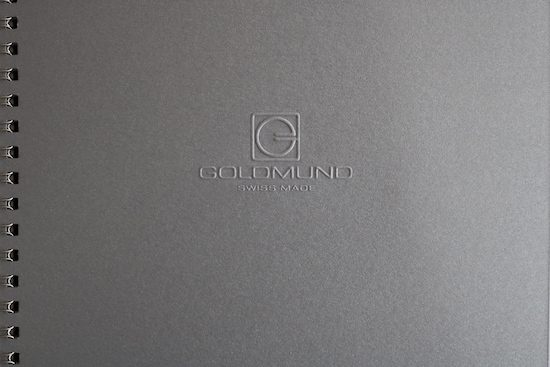
As far as I can tell, this is a class A/B design and as the unit does not get warm to the touch even in the slightest when idling (or when playing) it does not seem to waste much energy in the form of heat suggesting that it is not biased too heavily into class A.
The specifications on the website quote the amp’s power consumption as 1/8 Output Power at 8 Ω: 250 W (IEC 60065). While browsing the tech specs section I noticed a very healthy power rating of 2 x 215 W RMS into 8 ohms (IEC60065). The rating into 4 ohms and 2 ohms is not provided but going from what I hear with my easy to drive Kroma Carmens and the not quite so easy to drive, well, make that outright hard to drive, Magico Q5’s, the amp has more than enough control and plenty of power.
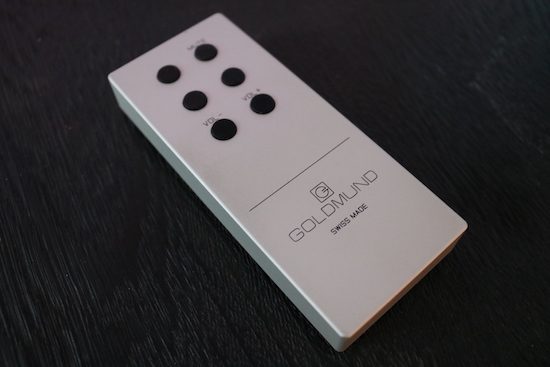
Full metal remote control unit
The Telos 590 Nextgen amplifier is extremely straightforward to operate. There are five analog inputs on cinch and 3 digital ones for Coax, Toslink, and USB. The front panel is occupied only by two rotary knobs for input and volume and a display. There is nothing to be configured on this amplifier: switch to the required input, set the desired volume level and you’re set. All the inputs are chosen sequentially with a single knob, leaving no distinction between analog and digital inputs. The power button is placed on the rear side but because the unit draws very little current, it can be left switched on indefinitely. If required, however, it can be switched on and off from the remote control unit, which also operates the input selection and volume level. The rear side also looks very straightforward: the aforementioned digital and analog inputs, a pair of speaker connectors, mains input and a power switch. There is no pre-out or main-in and the speaker connectors have a very simple appearance but these are all conscious decisions made to allow for the best sound quality.
Setting Up
The amp’s merits will be assessed in my own system and after that, I will also connect it up in audio buddy Niels’s Magico setup. The kick-off is with my main system consisting of a CH Precision C1 DAC and A1.5 power amp using Kroma Audio Carmen loudspeakers. The source is an Antipodes CX+EX server/renderer combo connected to the C1 DAC via a Final Touch Callisto USB cable.
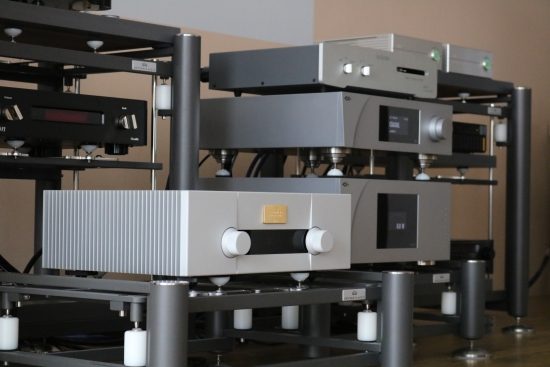
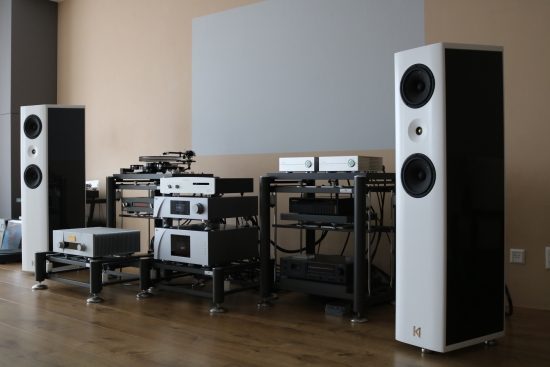
Normally, I use XLR connections but since the amp uses cinch connections exclusively (again, a conscious decision), for this occasion I used AudioQuest Water and Vermouth Reference cinch interlinks. As speaker cables, I used Furutech Nanoflux and Jorma Design Trinity. The power cables for all components were Belden 19364 with Bals schuko and Oyaide C-004 connectors.
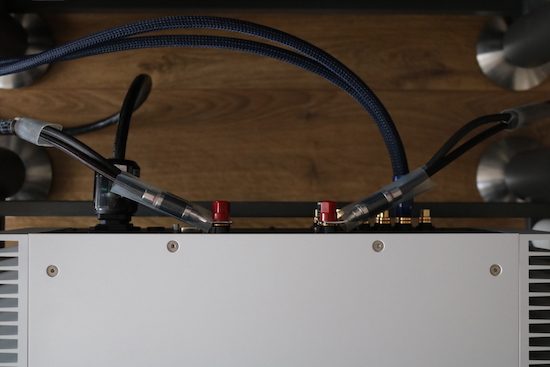
Belden 19364 power cable with Oyaide C-004 IEC connector, Furutech Nanoflux speaker cable and AudioQuest Water cinch interlink
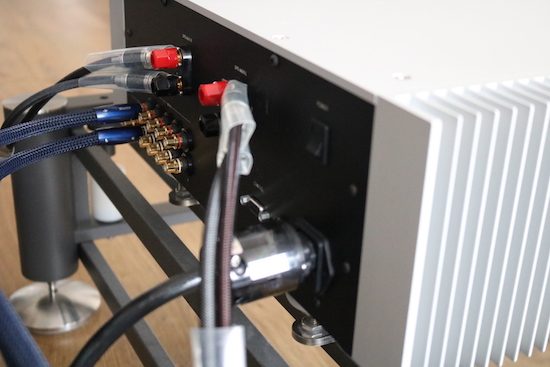
As the amp’s internal preamp and power amp sections cannot be separated, the initial comparison was between the CH Precision C1 as a volume-controlled DAC into the A1.5 power amp and the C1 with fixed output level as a pure DAC into the Telos 590 Nextgen’s analog input 1, labeled “4”, leaving its built-in DAC unused for now. To be fair, I used the same cinch interlinks (either AudioQuest Water or Vermouth Reference) between C1 and A1.5 as between C1 and Telos 590 Nextgen.
Warming Up
Although the amp does not get warm in the least it does need some time to fully come on song. Upon the first switch on it sounds impressively detailed and transparent right away but also quite dry for, say, the first 20 minutes. After about 30 minutes it starts to become more fluid and the midrange gains more continuity and color. After that, slowly, the amp’s sound becomes slightly warmer and smoother and I’d say that it is really cruising after about 2 hours.
Although CH Precision’s two founders Florian Cossey and Thierry Heeb both have a background with Goldmund and there are indeed some similarities between the two amps, they do have a different presentation in a number of ways.
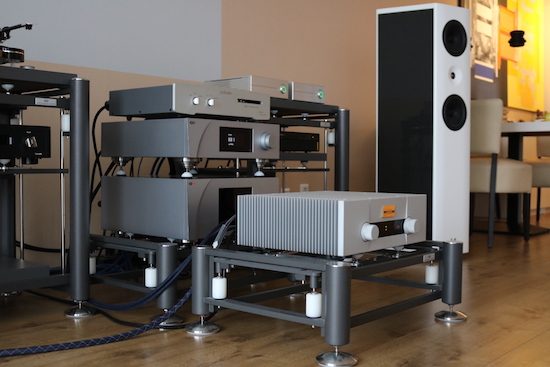
Sound with analog input
Overall, the amp sounds energetic, pure and explicit and highly lyrical, by which I mean that it is musically and emotionally involving. Its timbre is highly convincing and to my ears very natural. The amp also has excellent resolution and sounds utterly clear yet it combines its precision with a well-dosed amount of warmth and although it has a slightly forward delivery in the midrange compared to the gentler A1.5’s, this actually aids the liveliness of the performance, and the Telos 590 Nextgen certainly never sounds hard or nervous. In fact, one could also say that the CH Precision has somewhat flatter imaging than the Goldmund. In terms of soundstage width, the two are about equal. The amp manages to sound warm yet neutral and lively yet relaxed. Its bass is rounder and not as tight and articulate as that of the CH Precision A1.5 but still on the tight side of the average just as its treble behavior is not as refined and airy as that of the A1.5 but still considerably subtler and airier than the majority of other amplifiers that I have used. The A1.5 may be tighter but that can also translate to a more analytical sound for some listeners and in certain system combinations. In terms of transparency and subjective neutrality, the two amps are about equally great.
Especially the Telos 590 Nextgen’s midrange has a certain quality that makes it both musically convincing and pleasant to listen to. It’s a certain richness of texture and subtle warmth coupled to a density and direct-coupled-ness that is immediately appealing. The amp has enough warmth to avoid sounding cool yet it sounds upbeat and lively and certainly not slow.
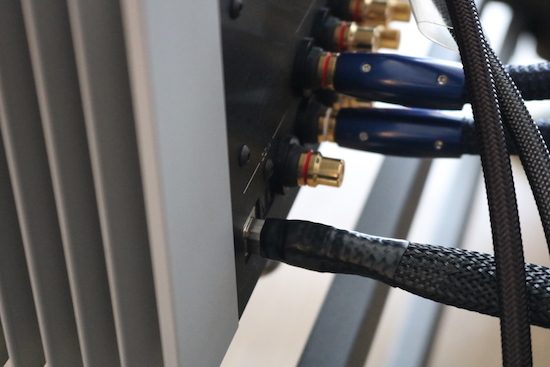
Final Touch Audio Callisto USB cable
Sound with built-in DAC
The built-in DAC is of high quality, on par with external DACs costing several thousand Euros. The DAC matches the amp in character as it also sounds precise, articulate and direct-coupled yet fluid and with a timbrally rich midrange. Sure, it cannot match the fullness, body, and refinement of the very costly C1 but still, the built-in DAC has a foot-tapping and engaging delivery that appeals immediately. Comparing the built-in DAC with external DACs with less eye-watering price tags than the C1’s such as the 6.860 euro Aqua La Scala and 13.670 euro Formula xHD DAC, there is still a case to be made for going with an external DAC, especially in terms of refinement and ultimate resolution but otherwise, the overall difference with these DACs is not exactly huge which says a lot about the Goldmund’s DAC board. One thing to note about the built-in DAC is that its precision and tightness can lead to dryness depending on the rest of the audio system that is less easy to tweak out as it can be done with an external DAC and its associated cables.
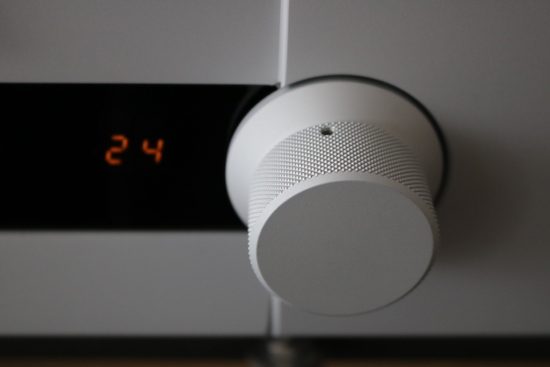
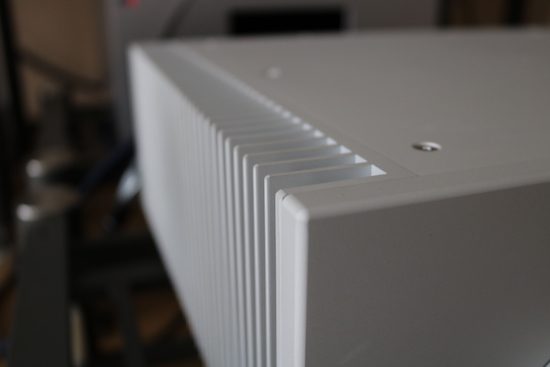
While I personally prefer the CH in my system mostly because of its low-level resolution and extraordinarily articulate bass I am also much impressed with the Goldmund mostly because of its engaging and organic midrange. Although both amps have certain areas in which they excel, overall, I can’t say that one outclasses the other. Both amps are very precise and essentially neutral and both avoid sounding overly cool. It’s really a matter of perspective, system matching, and personal preference.
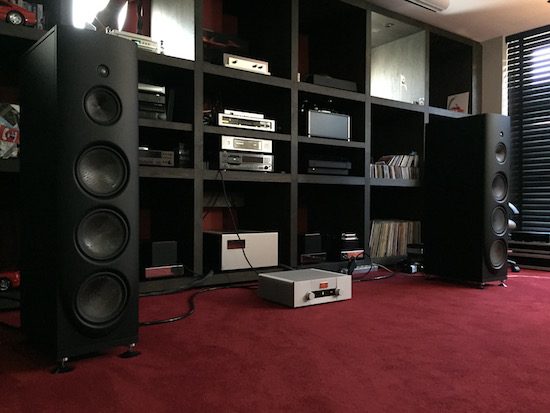
Magico setup
Since my Kromas are so easy to drive and are not really putting an amplifier to the test in terms of power delivery I thought it fitting to give the Telos 590 Nextgen also a run in the context of audio buddy Niels’ Magico Q5 system. The Q5’s dip to a 2.75-ohm impedance and have certain phase rotations that make them hard to drive well but as it would quickly become clear, the amp drives these speakers with gusto.
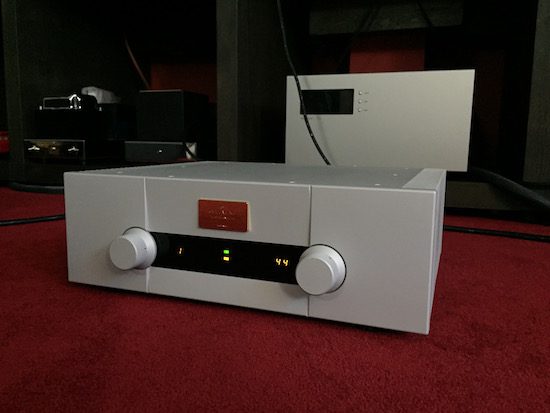
It’s not visible on this picture but the Telos 590 Nextgen has carpet-piercing spikes under its metal feet to make for a very solid coupling
The Magico’s are very revealing but the Goldmund behaved itself absolutely immaculately. There was never any harshness nor a hint of bite and never any shortage of power yet the sound was fast, tight and focused and absolutely not wooly yet also smooth and relaxed and very easy to get into. The Bricasti M15 that I listened to in Niels’ setup very recently was creamier and more relaxed but the Goldmund is spicier and more exciting and still possessing of a certain warmth that never gets in the way of the music’s communicative powers. Niels normally uses a Soulution 711 which is also of Swiss manufacture, just like the Goldmund and, indeed, my CH Precision. We’ve compared the A1.5 to the 711 in this setup on another occasion and we also carried out comparisons at my place. While it is tempting to draw a parallel between these three amps, really, they are different beasts.
What they have in common is that they all combine a high level of neutrality and precision with a pleasing musical flow and they all drive the Magico’s very well. Beyond this, their characters are pretty different. The A1.5 tighter, more agile and refined and the 711 darker, fuller, more 3D, and more thunderous in the bass. Among these two, the Goldmund straddles the middle path, taking some of the other amps’ best features to make for a presentation that is immediately satisfying.
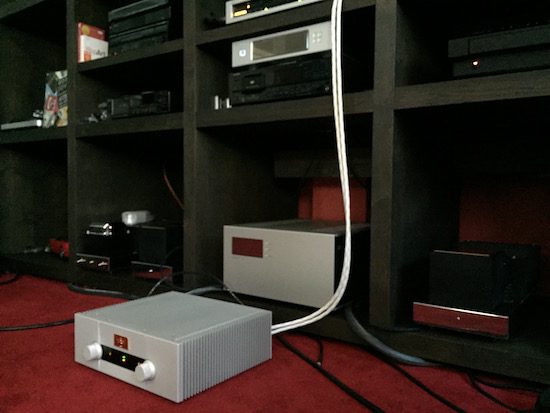
Understandably, the best sound in Niels’ setup was achieved using the Zanden 5000 Signature DAC’s analog outputs via Vermouth Audio cinch interlinks into the Telos 590 Nextgen. But the built-in DAC also fared very well. As I noted earlier in my setup the amp with its built-in DAC can tend to dryness and this was evident in Niels’ setup as well. Although the Zanden could not be equaled (which would have been a miracle) we could tweak the sound of the Aurender S10 using a selection of USB cables. The Mad Scientist BlackMagic sounded the smoothest and gentlest and was closest to the Zanden’s sound while the AudioQuest Diamond USB yielded the tightest, most articulate and most exciting sound, but it was also quite dry. Please note that there are many other great USB cables out there but in this case, I was confined to those with adequate length to work in Niels’ setup. As an alternative to the Mad Scientist cable, I have a feeling that the CAD USB-1 USB cable would also make a great match.
As I am nearing the end of this review, the thought occurs to me that the Telos 590 Nextgen is actually the best integrated transistor amplifier that I have heard so far. The only other amplifier that springs to mind as potentially approaching the Goldmund’s performance in some key areas such as neutrality and communicative powers in the midrange would be the 22K Analog Domain M75D. But that amplifier does not include a DAC and I’d have to hear them side by side to say anything more conclusive about it.
This amplifier has much impressed me. The only downside for me is its complete lack of any user adjustments. For others, I suspect many, that is probably a benefit but for me, having grown accustomed to the CH Precision’s level of expandability and user-adjustable settings, the Goldmund strikes me as spartan.
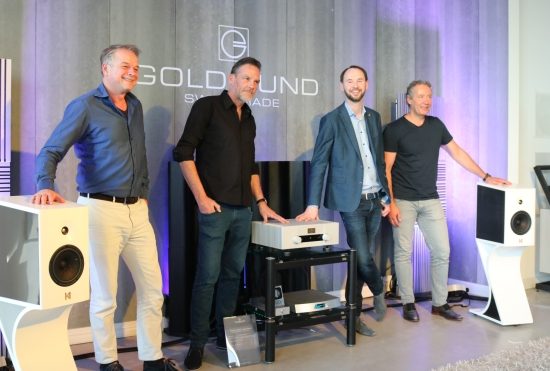
The Telos 590 Nextgen matched superbly with the Kroma Audio Julieta’s as well at the PUUR Audio, Video & Domotica showroom. Posing left to right: Ben van Leliveld, Robert Brijde, Daan Vreeswijk, and Kees Wijnberger.
Conclusion
While the best part of 30K is not exactly a bargain even if an integrated amplifier with built-in DAC is much more economical than separate components and it saves a lot on cables, the fact is that all the truly benchmark-setting amplifiers these days are priced either similarly or even higher. Alas, that’s the reality that we live in. In any event, the Telos 590 Nextgen absolutely and unequivocally delivers. It is the finest integrated amplifier that I have heard so far.

Distributor for the Benelux: PUURAVD.com
Manufacturer: Goldmund.com
Read Also
PUUR AVD Kroma Audio Mimi & Julieta
PUUR AVD Company Special
Goldmund Satya
CH Precision A1
CH Precision A1.5
Goldmund Brand Store Opening with Maya Fridman
More Niels comparisons
Apogee Full Range
Soulution 711 compared to CH Precision A1.5
Naiu Laboratories Ella
Bricasti M21 and M15 power amp (navigate to part 3)
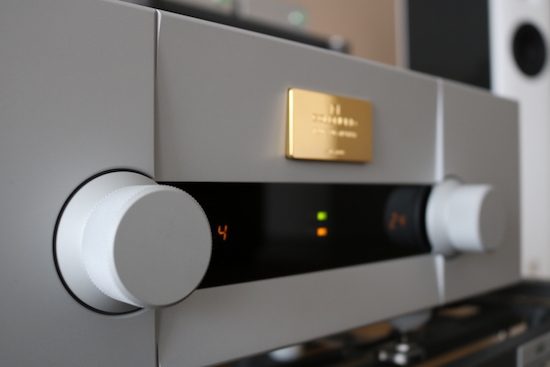
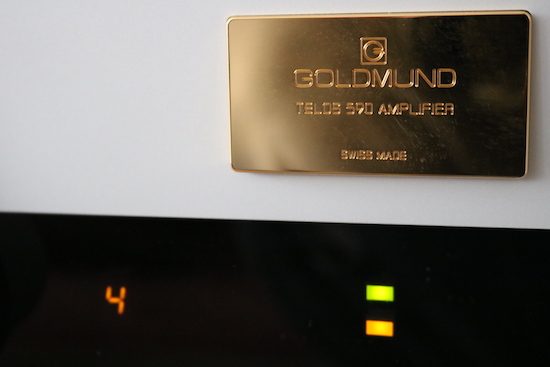
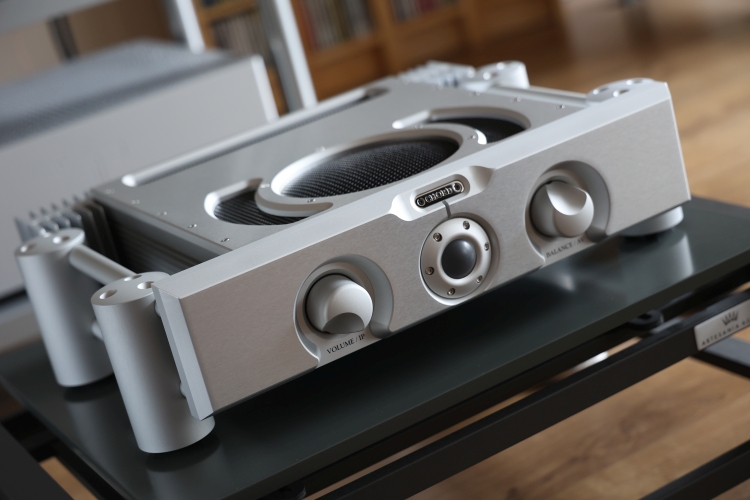
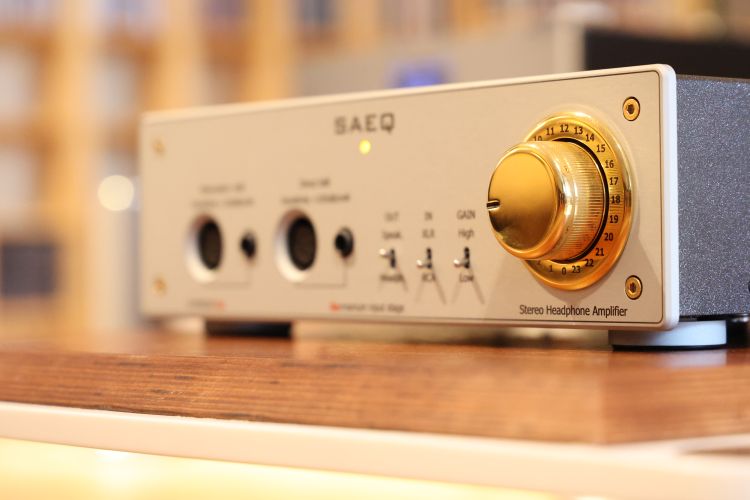
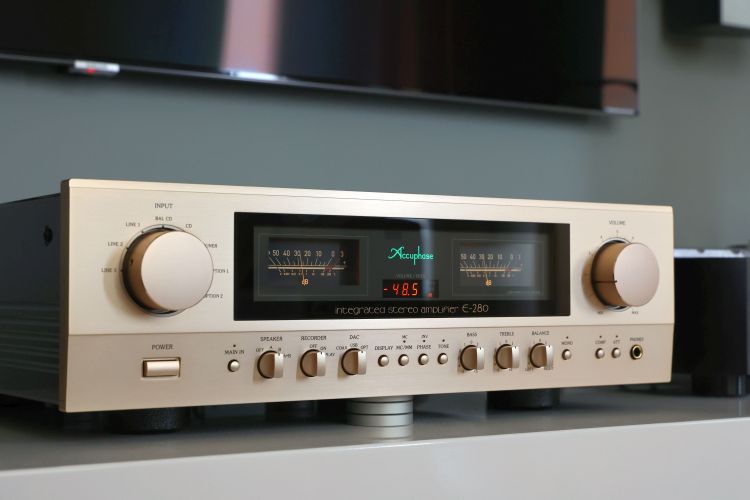
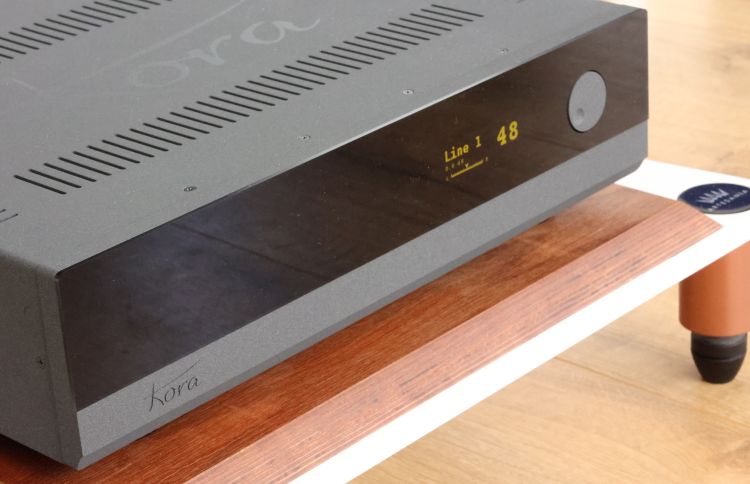
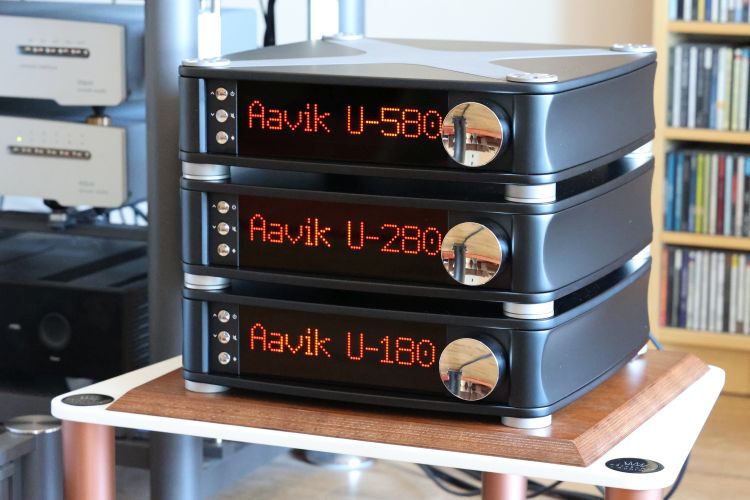
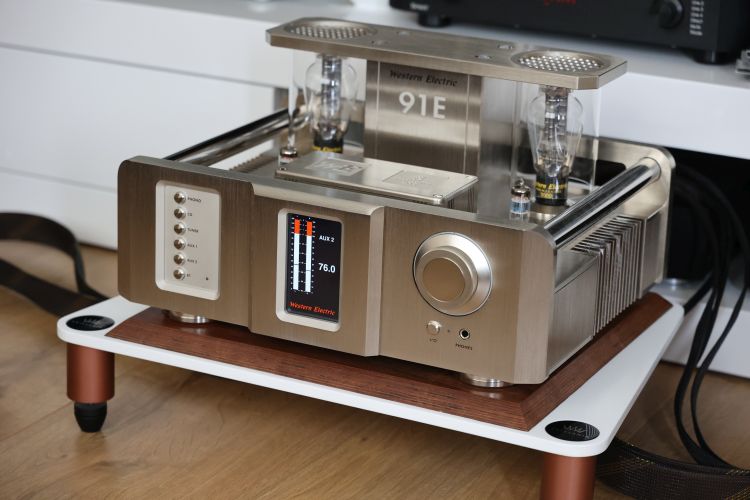
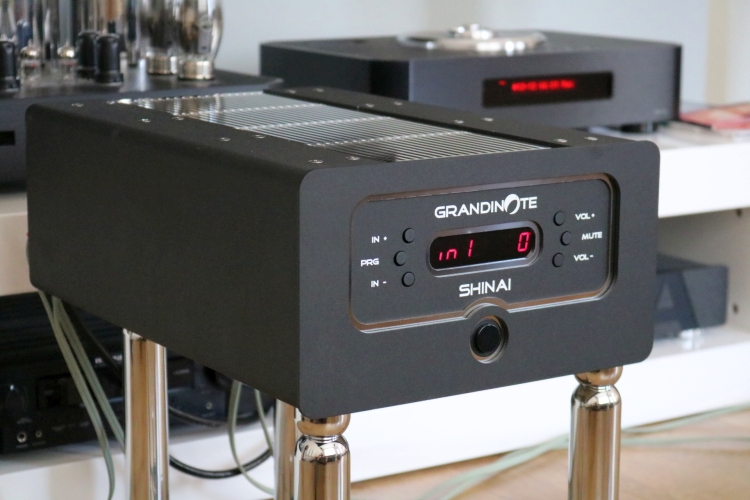
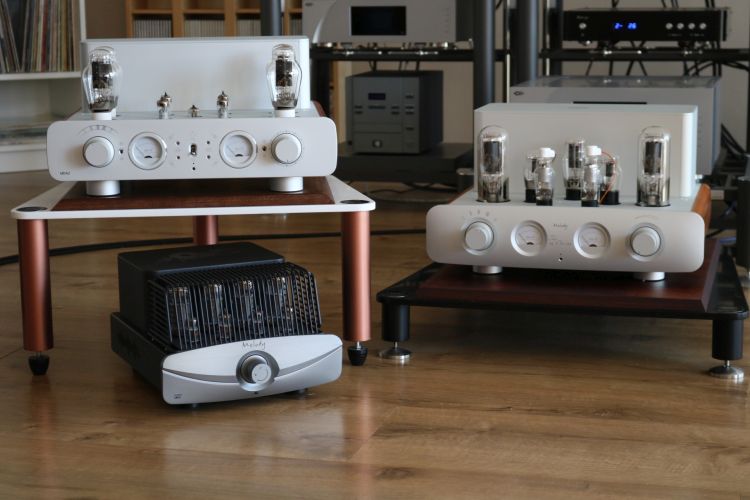
30, 000 for goldmund overpriced audio jewellery junk, you have got to be kidding me. My 1995/96 avi s2000mi would match it for sound quality, and I’m not kidding, which was far less money at around 1000 uk pounds back then. There is no way the goldmund is worth its money especially looking at its internals. Saying its the best integrated amplifier you have ever heard is a bit stupid in my opinion. So called new technology amplification by your words, does not make it better than my amplifier, in which my amplifier is extremely explicit in ts detail resolution, speed and harmonics, considering its powering passive loudspeakers, and not an active crossover powered system.
Mr Horwood – a couple of questions:
1. I assume from your comments that you’ve heard the Goldmund alongside your amp in your system ?
2. Where can I get one of these amazing AVI amps that you have, I guess they must be selling like crazy and the manufacturer must be hugely successful – if, as you say, they make the best amps ever ?
My amp is 24 years old and not made anymore. Avi stopped making audio separates and went into making active bookshelf loudspeakers years ago, with sound quality going a totally different direction. My amp was the first integrated amp they ever made, the avi s2000mi, and in my humble opinion, has remained the best that they ever made. Their newer amps could not do what their original amplifier could do. You do not see my integrated amplifier on the second hand market for sale, unless someone probably dies and a relative does not know what it is. Obviously you have never seen and heard one either. Telos is using similar technology that linn has used in their products but implementing it differently. I know what kind of kind sound this gives you, which I am far from against, it is the kind of sound I prefer. Clarity speed and bandwidth given to you all at the same time. I had a full linn aktive system 30 years ago, and was ok in many ways, if you knew what you were doing, and ways to maximise getting the best out of them. But here I am going of subject. For my old technology amp does exactly what this new expensive goldmund integrated amplifier does, has an ability of been uncoloured, clear, have clarity, while been very fast, have dynamics, harmonics, bandwidth, and most importantly plays with energy and emotion, all with no ear fatigue. Obviously the old equation is rubbish in rubbish out, meaning source components, loudspeakers, cables, all have to be able to deliver the same attributes too. My Amplifier as a passive integrated amplifier is as is as good as it gets for its type of breed and is a veritable microscope of detail retrieveval, speed and and harmonics, but you cannot make perfection out of a sows ear in poorer and compressed recordings. Having heard lots of amplifiers, systems, source components. What I can tell you is, amplifiers with a vast multitude of of output devices, complex circuitry, lots of wiring, is very bad for sound quality, leading to having total outright poor signal to noise and channel separation reproduction in quset for ultimate power, or total full class A operation. If you want all the sound qualities mentioned above, it does not come from components with complex and vast mutiple output devices with quite poor total noise and seperation abilities, aiming for lots of watts or total class A operation needing needing vast multiples of power devices. In my honest opinion every high quality system should be capable of the loudspeakers drivers been driven independently, by its own independent amplifier, passive or active operation, and not complex passive crossover components eating up detail and power requirements from a single amplifier. Each loudspeaker driver should be driven independently, with a highly resolving, detailed, fast and wide bandwith response and and have all the traits needed for the musical signal. Lots of poor overpriced components and systems do not perform, and perform very badly for their exorbitant prices. What is totally frustrating is that there are too many so called high end expensive brands and products, having poor noisy, and complex circuits. Some have lots of wires and wiring, having a marathon of output devices in amplifiers, leads to ultimately poor sound quality. Having very complex passive crossovers in their loudspeakers, while also having a very noisy reflex ported mess of sound. This is not the way to the best attainable sound possible, while having the cheek and audacity to charge you a Kings ransom for the privilege for a pile of poor performing poo of sound. The total mounting up and build up of all those bad sonic attributes and traits, in a whole and very expensive audio system, is so detrimental to sound quality, which in turn totally leads them to having poor abilities, and you end up with a soup of mess for sound quality, while including and charging you an obscene amount of money in the process. The most expensive audio jewellery brands and products are just that, and are not the ultimate products in the quest for making and maintaining the ultimate high quality and fidelity of sound quality and signal transfer.
You obviously cannot be old enough to have heard and no this 24 year old amplifier. It is now a rare piece of audio kit, and persons who own this amp never tend to sell them. It has the best of linn and naim qualities combined but without naims worse qualities in their amplifiers. As I said the amp is clear, detailed, fast, has harmonics and air with bandwidth, and has the emotions left intact. The better the clarity and detail resolution retrieval with speed harmonics and air of a high resolution source component can relay, those products that have a quiet noiseless power supply for their circuirty and audio output, and with loudspeakers and cables able to relay this sort of resolution and detail , you get the picture. Loudspeakers with lots of and very complex crossover components and bass reflex ports is a know go, these kind of loudspeakers will never get the detail speed resolution harmonics and air of soundscape across left intact.
Hi Christiaan,
ik ben in het bezit van twee sets prachtige mono-eindversterkers (Goldmund Mimesis 9.4 en Audio Research 610T). Beide sets zijn ‘oud’, ik schat tussen de 15-20 jaar. Nu vraag ik mij gezien de ontwikkelingen op versterker-gebied af, wat hoorbaar de sprongen zijn (zo die er al zijn), die worden gemaakt als ik naar een versterker van recentere datum zou overgaan. En welke versterker(s) zijn capabel om mijn huidige te vervangen waarbij hoorbaar significante winst is te halen? Als voorversterker gebruik ik een Audio Research 5se, speakers Wilson Audio Maxx3. Bronnen: Spectral cd speler en Pluto Audio draaitafel met Van den Hul phonotrap.
Alvast dank voor je respons!
Hi Bart, The Ref5SE is simply great and if you like its balance of virtues it will be very difficult to improve on it in a general sense especially if you want to avoid breaking the bank. At best, you could improve certain aspects at the cost of others. I’d suggest just sticking with it.
While your power amps may be ageing, they may still be excellent as long as the capacitors are in good shape. You might want to consider first just having them checked to see if they are still on spec. I’m assuming that you are using these power amps in a bi-amped configuration? In that case you have likely achieved a carefully-made balance that is easy to upset by using new/different amplification. Any new amps would need to match the Maxx3’s and also have to fit in with your taste preferences and that makes it difficult for me to make good suggestions.
A very worthwile upgrade can certainly be made on the power amp side but the question is in which direction you want to steer your sound.In general, the trend in amplification is a faster, more articulate, cleaner, more immediate sound. While I have not compared the Telos 590 NextGen to any preceding Goldmund amps, I’m pretty sure that the progress for this brand must also have been considerable since I have not heard anything more agile or more transparent than the Telos590. I’m betting that newer Goldmunds than yours (such as the 590 or its bigger power amp siblings) would sound considerably quicker and more articulate. But the improvements in these areas usually come along with a less voluptuous tonality and that would also need to be what you are looking for. In that sense, “better” is to some extent a relative matter.
I’ve not heard your exact type of Wilsons but over the years I have heard a lot of them and have owned the WP8, which in terms of midrange/treble performance is likely more similar than different. What I found to work very well with these speakers are CH Precision A1.5, Goldmund Telos 590 NextGen, and Soulution 711. If you’d want to aim for the best transparency and neutrality then the CH and the Goldmund are what I’d go for first. Both amps have a modern and super-neutral sound and of the two, the CH is gentler and more refined and the Goldmund is more immediate. The Soulution 711 still sounds considerably fuller and more sonorous and is less subtle and refined than the other two. Of the three Swiss amps, it is the least “analytical” which may be a good thing or a bad thing depending on your view. In any event, I like all three for different reasons. The upside of the 711 is that you won’t need to bi-amp as it has plenty of current available. Arguably the most musical combination I have heard with the Wilsons yet was with classic VAIC SET amps (now part of Ayon), but this was as far removed from the Swiss precision and neutrality as is humanly possible. If you want a full tonal balance and stick with tubes but don’t want the thick or woolly bass that often comes along with this, then I’d suggest to investigate Ayon and Zanden. Both have a powerful and tonally full sound that works well with the Wilsons.
Thanks for your quick response Christiaan. I think I’ll stick with the MM Goldmunds. Concernering your bi-amping remark, this is not recommanded by Wilson. I inquired with the same question a while back and was told NO by Wilson.
This has something to do with the crossover in their speakers and even though there are multiple binding posts the speaker will not operate properly when trying to bi-amp.
Even better:-) I’ve not obtained very mixed results bi-amping with different amplifiers and don’t generally recommend it.
I would need to see the insides to judge the value of this amp.
30K is a lot of money and the only amp I’ve seen worth its asking price are the Gryphons.
If you saw the inside then I’d wager you will feel it is not worth the asking price. Look it up, images can be found online. But when you listen to it, that’s another story.
Hi
I have been using CH C1.2, X1, L1, M1.1 for some time for roon streaming to drive my Kharma Exqusite Midi 3.0. For budget reasons i had to shrink the system a bit and sold the Kharma’s and L1, M1.1 and bought Goldmund Telos 690 integrated and Alara Labs Remiga 1 Diamond. I am more than happy for now but i wanna further with this shrink and want to ask you a question. How is the dac on Talos integrated? (590-690 maybe similar) If i sell CH C1.2 and X1 do you think adding a great streamer to telos 690’s dac will collapse the the system performance? If it will Mola Mola Tombequie or La Scala etc. can do the job?